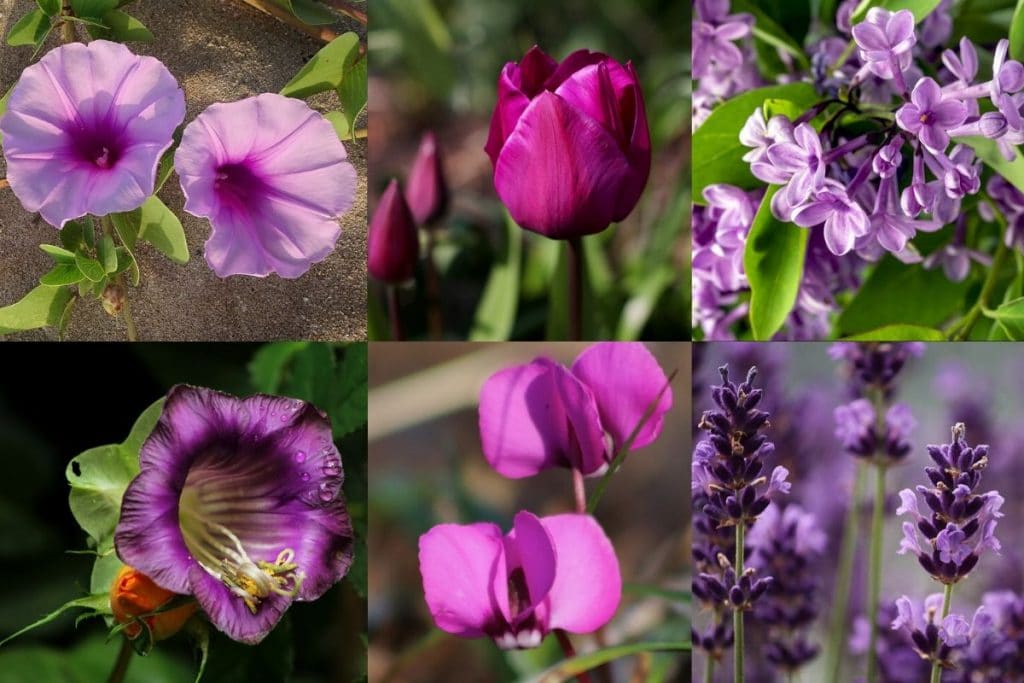Purple color is the result of mixing calm blue and passionate red. It is often associated with royalty, nobility, power and luxurious life. It is not a color that can be found in nature regularly which makes some cultures believe that it has sacred meaning [1].
- #1. Lavender
- #2. Lilac
- #3. Violets
- #4. Hyacinth
- #5. Tulip
- #6. Wisteria
- #7. Cobaea
- #8. Ipomoea
- #9. Trachelium
- #10. Cyclamen
- #11. Lisianthus
- #12. Passiflora
- #13. Browallia
- #14. Campanula
- #15. Astilbe
- #16. Verbena
- #17. Clematis
- #18. Lily of the Nile
- #19. Peony
- #20. Monkshood
- #21. Rhododendron
- #22. Allium
- #23. Bougainvillea
- #24. Carnation
- #25. Sea Thistle
- #26. Crocus
- #27. Columbine
- #28. Bell Heather
- #29. Foxglove
- #30. Comfrey
- #31. Catmint
- #32. Fuchsia
- #33. Gladiolus
- #34. Geranium
- #35. Bee Orchid
- #36. Baptisia
- #37. Coneflower
- #38. Aster
- #39. Petunia
- #40. Hibiscus
- #41. Lupine
- #42. Lily
- #43. Periwinkle
- #44. Iris
- #45. Morning glory
- #46. Anemone
- #47. Mystic Merline
- #48. Balloon flower
- #49. Scabiosa
- #50. Hydrangea
- #51. Blue-eyed grass
- #52. Sea holly
- #53. Bellflower
- #54. Chrysanthemum
- #55. Zinnia
- #56. Cosmos
- #57. Pasque flower
- #58. Bittersweet nightshade
- #59. Alpine betony (Stachys monieri)
- #60. Salvia (sage)
- FAQs
The Purple Color and Its Meaning
Purple flowers are considered rather delicate and luxurious treasures and are thus, valued by gardeners and observers for their uniqueness and beauty. Very often, purple flowers are perceived to look artificial due to their distinctive color shades, forms, and beautiful blooms.
Purple signifies luxury, wealth, high social status, royalty, and complexity. In different cultures, the color has various symbolic meanings.
For example, in East Asia it is related to wealth, comforting and sorrow, privilege, and mourning. In Western countries, purple is related to royalty, rich social status, reputation, the position of power and control [2].
The purple color is known to have a direct effect on certain human emotions, such as relaxing the mind and the eyes, calming nerves, developing spirituality, enhancing sensitivity, sense of fulfillment, self-confidence, passion, happiness, completeness, and encouraging creativity and imagination [2].
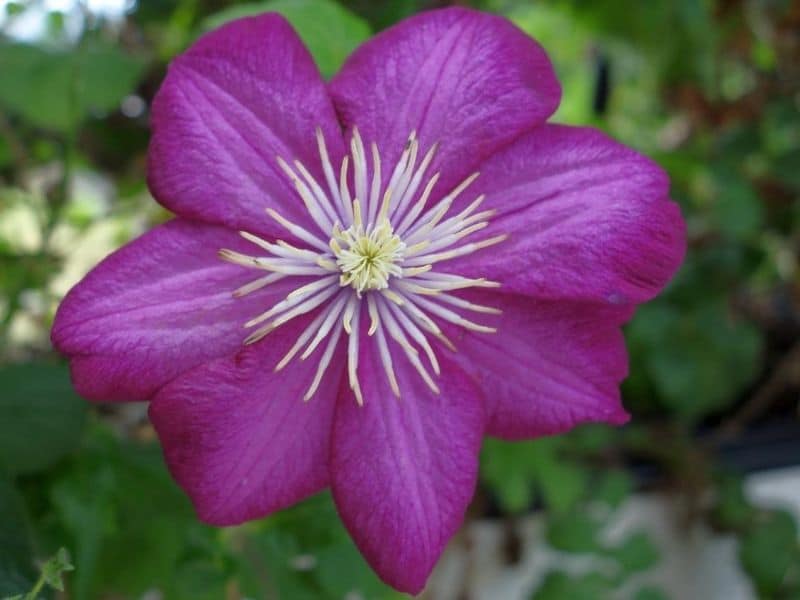
Sometimes darker versions of the color can evoke negative associations and perceptions of sadness, loneliness, frustration or mourning. In general, the purple color represents a youthful spirit, contemporary views, creative thinking, royal wisdom, spirituality, dignity, prosperity, respect, and mystery [2].
This is why, if you want to attract attention to your garden design or simply admire its unique beauty, choosing purple flowers to plant in it is always a good idea. As it is a rich color, purple should not be overused and rather be selected as an accent or combined with other palettes.
Due to its richness, it can be combined with either similar (e.g. pink, blue, etc.) colors or contrasting shades (e.g. yellow, white, etc.).
If you have already fallen in love with purple and put it in your garden bucket list but still struggle to think of different floral options, this guide will walk you through our top most beautiful flowers that you can use!
Here’s our list of purple flowering plants:
#1. Lavender
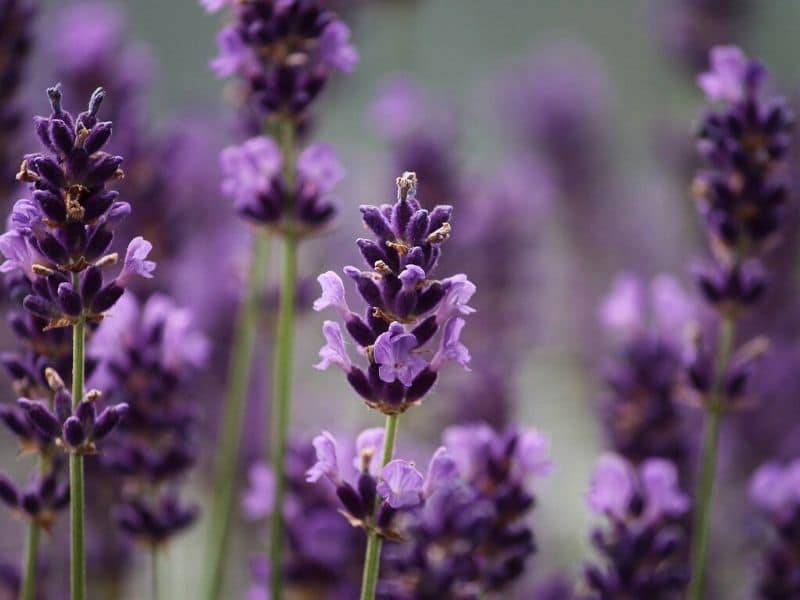
Lavender is most likely the first flower that pops up when you think about purple color. It brings delicate elegance and strong unforgettable fragrance to your garden and is relatively easy to grow and care. It enjoys full sun to partial shade and well-drained soil. It prefers dry climates but is rather adjustable to different conditions and can be grown in various regions.
Until it is well established, you can water it more regularly and slightly decrease it once it is well grown. Lavender’s scent is very strong and distinctive. You can cut some of this perennial, dry it and use it as home decoration or wardrobe aroma.
Lavender is also often used in cosmetics and aromatherapy products because of its fragrance and essential oils extracted from it. In some countries, people even use dry leaves of lavender as tea. You can remove dead flowers to encourage new blooms.
Different varieties of lavender bloom in different seasons, but the most common period is during the summer.
#2. Lilac
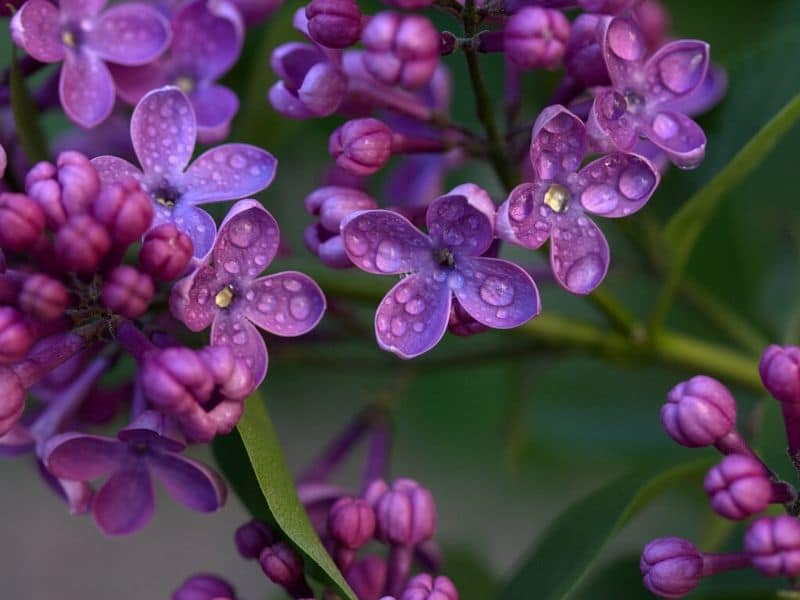
Lilacs are easy to fall in love with. Their strong fragrance and beautiful big flowers in varying colors from white, through pink to dark purple, are eye-catching and attracting butterflies which can further contribute to your garden paradise’s beauty.
Depending on the specific varieties of lilac that you have, lilacs can bloom during late spring, early, mid or late summer. They are relatively easy to grow, especially when they are once well established. Lilacs enjoy full direct sunlight (which determines the intensity of their blooming), well-drained soil and medium watering.
When planting lilacs in your garden, keep in mind that, if taken care of well, they might grow significantly, reaching 15 feet height and up to 12 feet width. Also, these dark purple flowers are spreading relatively easy, so you might ensure that other garden areas are not occupied and you ensure they have space to grow.
#3. Violets

Violets are perceived by people as a symbol of happiness and smiles which makes them a colorful and joyful addition to your garden. They are also edible flowers, which often leads to using them as plating decorations and addition to gourmet specialties.
Depending on the specific sort chosen, these purple flowers bloom from spring to autumn and the variety of colors is quite rich, including white, yellow, pink, purple, blue, orange and burgundy. These flowers prefer direct full sunlight, moderate watering, and well-drained soil.
#4. Hyacinth
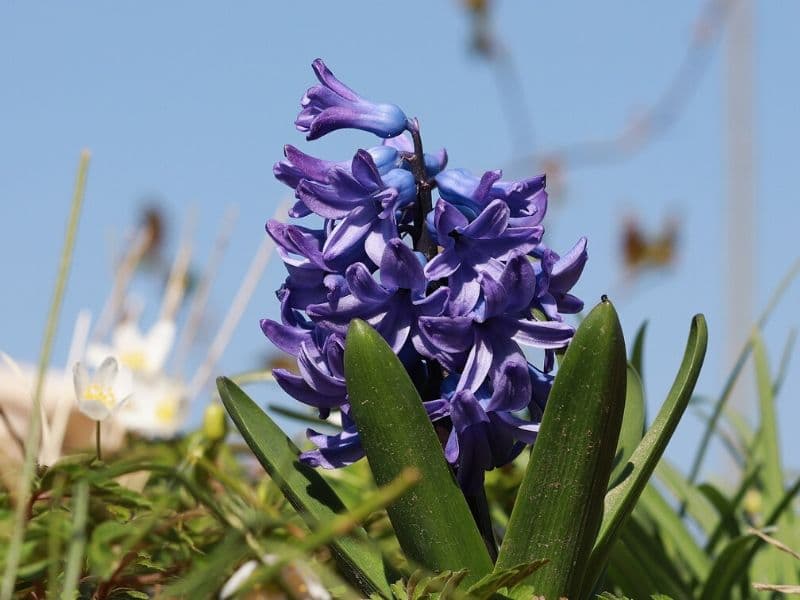
The hyacinth is a spring ‘must-have’! Their unique beauty combined with strong aromatic fragrance makes them a real treasure for your garden. They are relatively easy to grow and care from bulbs, which are planted in late autumn to bloom early spring.
They are quite resistant to heavier winter conditions and are relatively adaptive to various types of climate conditions. Hyacinths bloom in many different colors among which are white, pink and purple in various shades.
If taken care of, good hyacinths will bloom year after year, so you might consider that when planning their position in the garden. You can also use hyacinths for innovative and distinctive Christmas decorations.
#5. Tulip
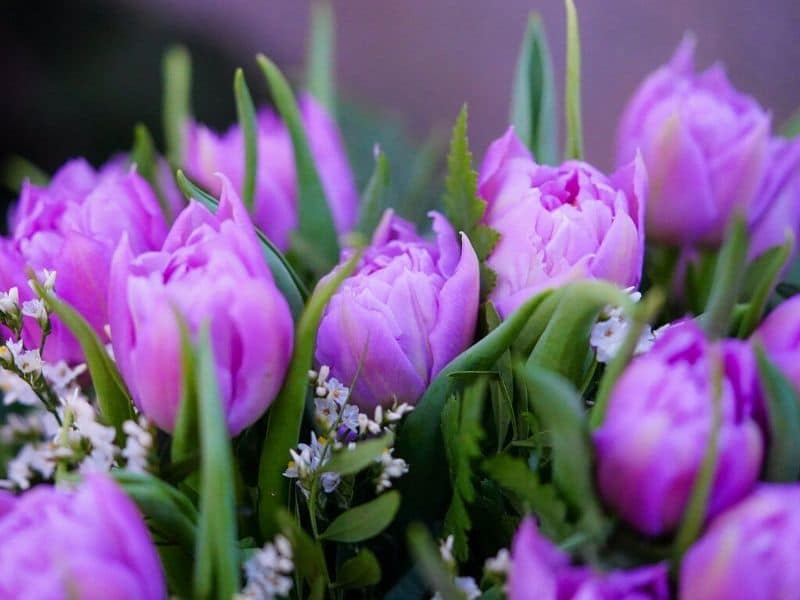
Tulips are also often chosen by gardeners for the creation of a spring paradise. Despite their relatively short blooming period and life of flowers, their distinctive beauty is often a reason for including them in the plans for a spring breath-taking landscape.
They are also blooming every year if the bulbs are left in the ground or stored properly. To bloom in the spring, you need to plant tulips in late autumn. Keep in mind that tulips are relatively easy self-spreading when planning their position.
There are many types and sorts of tulips but the majority of them prefer the same conditions to grow and care – direct full sunlight, regular watering, and well-drained soil.
#6. Wisteria

This is one of the most beautiful vines you could have in your garden. It is a high-climbing vine which blooms with large clusters of blossoms hanging down. Usually, it blooms in the spring but, depending on the sort and the climate, it might also bloom in early summer.
The colors you can choose from are blue, pink, purple and different combinations of these. The vine can grow up to 30 feet long but is quite sensitive, so you might want to provide support to climb on and create beautiful decorations based on your taste of shapes.
Due to the aromatic fragrance wisteria plants have, they are often attracting many birds and butterflies, further contributing to the creation of a garden fairytale. It enjoys direct full sun, regular watering, and well-drained soil.
#7. Cobaea
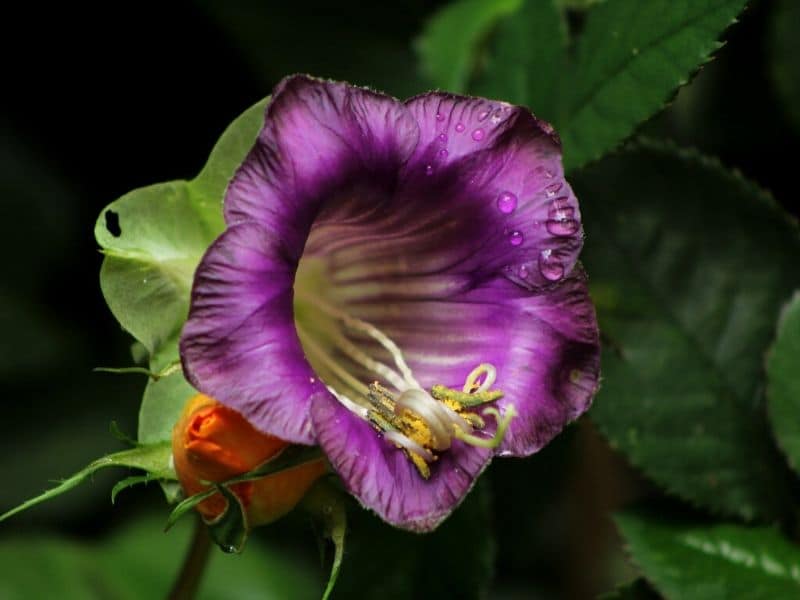
This flower is a beautiful annual which, if transferred indoor during winter, can also be grown as a perennial. It blooms in purple and white color and has many bell-shaped blossoms during mid-summer and autumn seasons.
It is a vine that is usually used for decorating fences, walls or other barriers in the garden. It prefers a relatively warm climate and full sunlight or partial shade position. It is grown through seeds planted in the spring. It enjoys regular watering from spring to autumn and rarer during the winter period.
#8. Ipomoea

This is a beautiful annual which blooms continuously with funnel-shaped flowers from June to October. Some types of Ipomoea are vines and need support to grow on.
These flowers prefer relatively warm weather conditions and a minimum temperature of 7°C in the winter if you want them to survive this season and be a perennial. It enjoys regular watering, well-drained soil and putting drops of water on the leaves from time to time.
#9. Trachelium
This is a quite sensitive flower which is usually annual but is worth having in the garden for its tall (up to 40 cm) stains topped with purple rosettes of small blossoms.
When the flowers die, you can remove them to encourage new blooming and greater stems rising. This flower prefers relatively warm weather, full sunlight or partial shade and regular watering.
#10. Cyclamen

Cyclamen flowers are very beautiful additions for any garden which can bloom in a variety of colors, including purple, pink and white. They grow up to 24 cm in height and 25 cm in width. The flowers are topping leafless stains surrounded by pretty dark green foliage.
They can bloom during all seasons if exposed to direct sunlight and watered regularly. During the summer it is a good idea to plant them in a partial shade position to avoid sunburn.
In the winter, if temperatures are below 10°C, you have to place them indoors to prevent freezing. It enjoys regular watering during blooming periods.
#11. Lisianthus
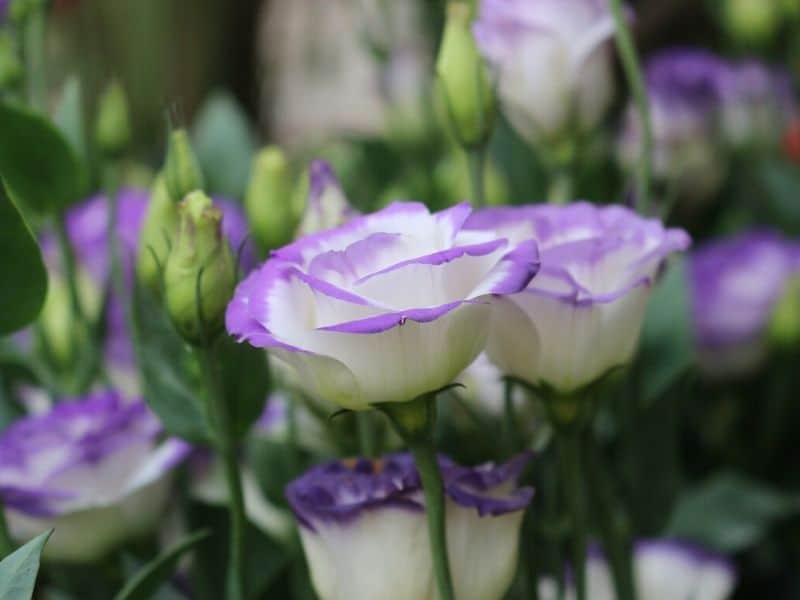
This summer bloomer is impeccably beautiful with its stems full of white, pink or purple flowers that can reach up to 60 cm in height. It enjoys full direct sunlight and high humidity climates.
These vibrant flowers prefer regular watering but you might leave the soil to get a bit dry between the rounds. Its beautiful bell-shaped flowers can significantly contribute to a real garden paradise.
#12. Passiflora
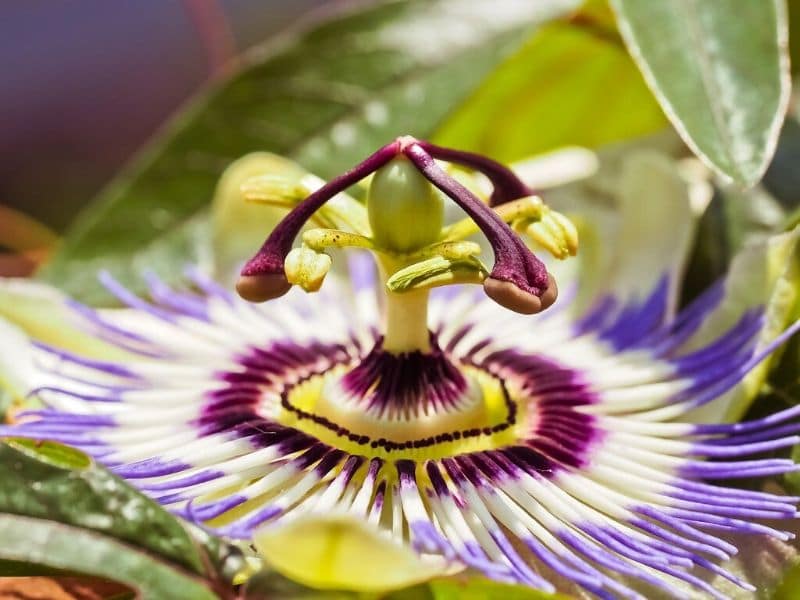
Passiflora (passion flowers) is a beautiful flower which blooms in different colors, including yellow, white, purple, blue or red during the whole summer period. Each flower opens in the morning and lasts only one day but it’s easily replaced by others.
Passiflora is a perennial which grows relatively fast, prefers humid climates, direct sunlight and regular watering, especially during the blooming period. We advise you to pulverize the deep green leaves during the summer when it is too hot but not when the flower is exposed to direct sunlight as it might burn (you can do it in the evening).
#13. Browallia
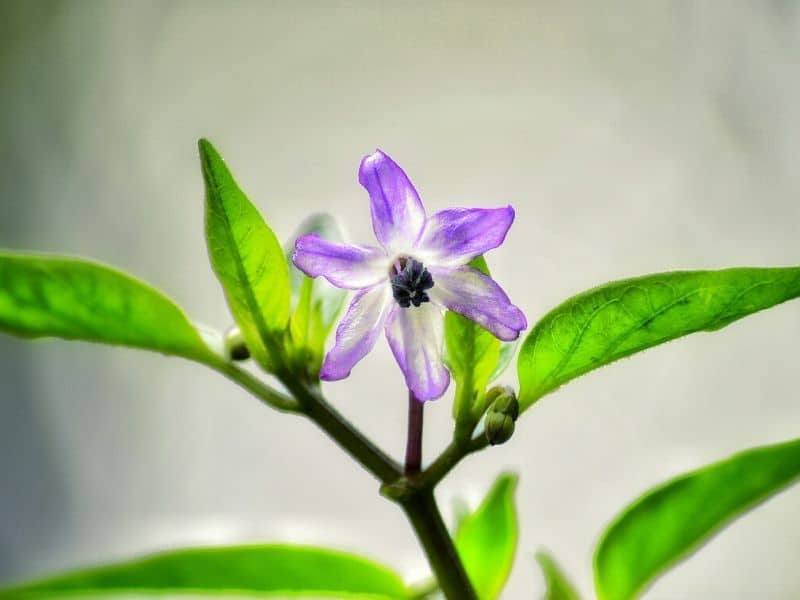
This bush-like plant can reach up to 150 cm of height and be full of purple flowers from July to September. It enjoys places with indirect sunlight, relative humidity, and regular watering during the blooming period.
When the flowers die, remove them to encourage new and longer blooming, as well as faster growth of the foliage.
#14. Campanula
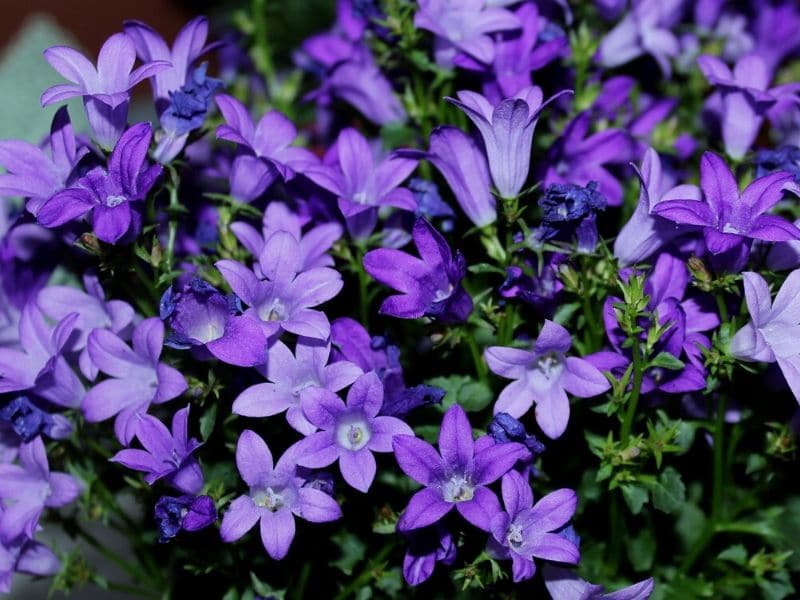
The campanula flower is a long-blooming beautiful purple flower which can give a delicate touch to your garden design with flowers from mid-spring to mid-autumn.
It has bell- or star-shaped blossoms and can be trimmed in different forms, such as a ball. It prefers bright areas with a lot of indirect sunlight as, if exposed excessively to the sun directly, it might burn.
Ideally, it prefers moderate humidity and climates which are not too hot or too cold. In the summer, it enjoys regular watering. You can grow it from seeds.
#15. Astilbe

Astilbe is a distinctive perennial flower which blooms throughout the whole summer period in white, pink, purple or red. Depending on the specific sort and climate of the area where it is planted, it can grow up to 2 m in height.
It prefers areas with partial shade, moderate watering, and well-drained soil. It is quite resistant to cold, which makes it a good choice for regions with colder winter seasons. You can grow it either from seeds or from directly planting young astilbe plants.
#16. Verbena
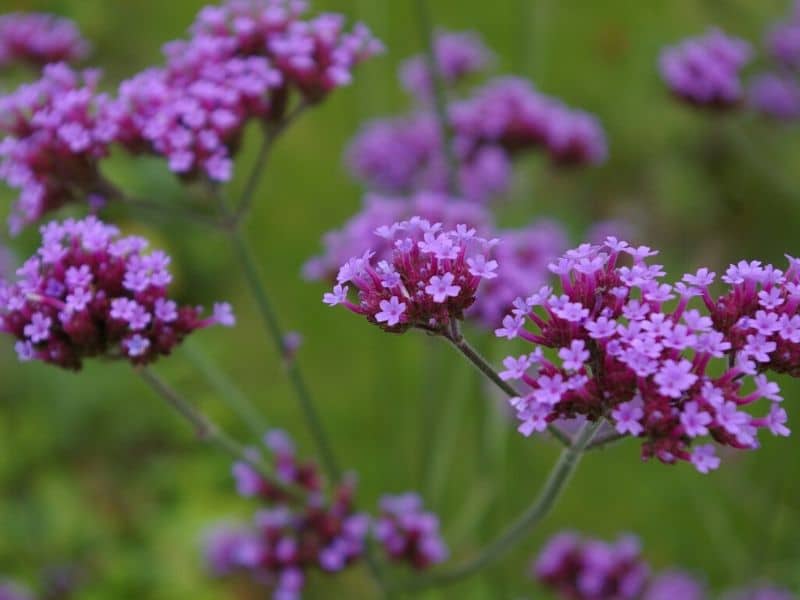
This flower blooms all summer long and forms beautiful clusters of small blossoms that grow up to 18 inches in height.
It blooms in a rich palette of colors, including purple, blue, red, pink and white. It prefers direct full sunlight (approximately 10 hours per day, if possible), moderate watering and well-drained soil.
One of the qualities of the verbena flower is that it is quite resistant to sun and heat which means you can expect it blooming even during the hottest days. In case you live in an area with relatively high humidity, our advice is to choose a perennial verbena to enjoy a longer and richer floral cascade during the summer.
#17. Clematis

This is one of the most breath-taking vines with purple flowers you can have in your garden. No matter which specific sort you will choose, it will reward you with beautiful scenery full of flowers which are usually blooming between early spring and autumn.
Clematis sorts have different growth and care needs depending on the type chosen but share some common features like a preference for direct full sunlight of a minimum five hours per day, moderate watering and well-drained soil.
Clematis can grow up to 30 feet in height and often need some kind of support, so you might want to plant them next to a wall, fence or additional decoration frame used.
#18. Lily of the Nile
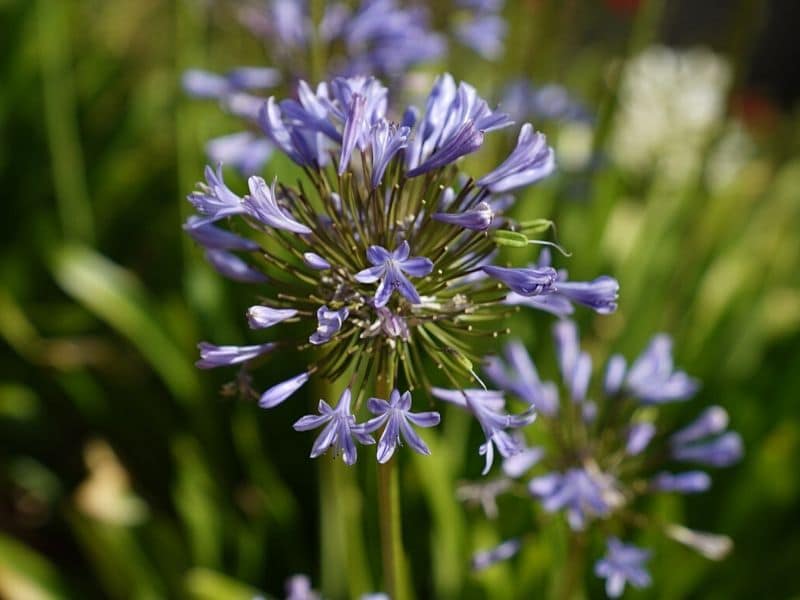
This beautiful flower forms round clusters of blossoms that vary in color from very light blue through purple to deep violet. It can reach up to 4 feet in height.
The flower enjoys average watering and well-drained soil. If you want to encourage blooming, it is a good idea to use soil supplements but up to a limited extent.
To protect the plant and have it for many years, do not cut the foliage after the bloom finishes, leave it to die naturally and remove it when dried out.
#19. Peony

This spring flower is a garden superstar. It can be found in a variety of rich colors, but the most common are purple, pink and red. The blooming period is in late spring. The flower rosette is relatively big and also attracts with its strong aromatic fragrance often used in the perfumery industry.
If you plant peonies in your garden, keep in mind that depending on the specific sort chosen, they can grow up to 4 feet in height and width, so give them the space they need to develop well.
If you want to encourage more and longer blooming, plant them in a place with direct sunlight for the whole day, water them regularly and ensure that they have moist and well-drained soil.
#20. Monkshood
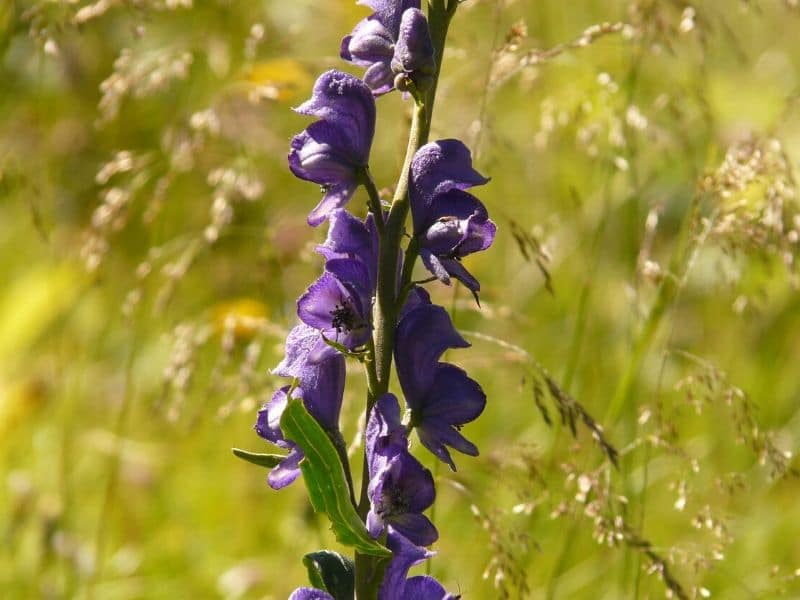
This flower is one of the prettiest additions you can have in your garden which most often blooms in deep purple colors (although available in other palette varieties too).
Keep in mind that the plant is poisonous, so it is not a good idea to plant it in gardens with easy access for children and pets. It prefers moist and well-drained soil and grows best when planted in a partial shade area.
These flowers are relatively slow-developing, so you have to be patient and give them the time they need to start blooming.
#21. Rhododendron
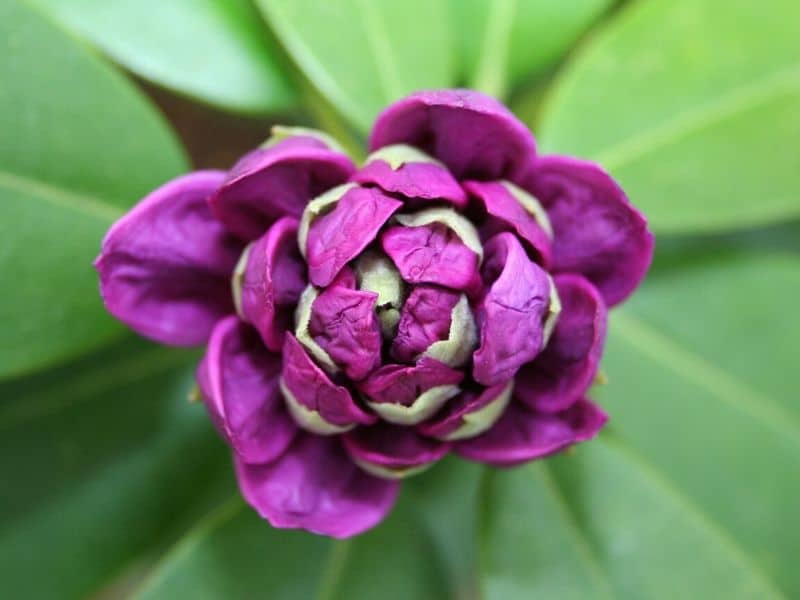
Rhododendrons are also an impressive addition that would give your garden a fairy look. If taken care of well these plants will reward you with long-lasting continuous blooming from mid-spring to mid-autumn.
Rhododendrons can be found in a wide variety of different sorts, colors, shapes, and sizes. The most common types bloom in purple, pink, burgundy and red. Some sorts can grow significantly and reach up to 14 m height, so keep this in mind when you select the sort and choose the location of planting in your garden.
This flower grows best when planted in a place with partial shade which can protect it from direct sunlight and burning. Rhododendrons are sensitive to extreme weather conditions (too hot or too cold), so if you live in an area with heavy winter, you might plant it in a big pot and move it indoors for this period.
Growth and care tips would depend on the specific sort chosen. For more information about this plant, visit our guide how to grow Rhododendrons.
#22. Allium

These attention-catchers can be found in many colors, blooming periods, height, and shapes. The flower is usually ball-shaped and placed on the top of a tall stain and thus, can be used as cut flowers and a part of vase floral decorations.
The size of the flowers can reach up to 10 inches. The leaves of the alliums are usually long which contributes to the beauty of this plant. Alliums bloom in late spring or early summer and prefer partial shade, average watering, and well-drained soil.
#23. Bougainvillea
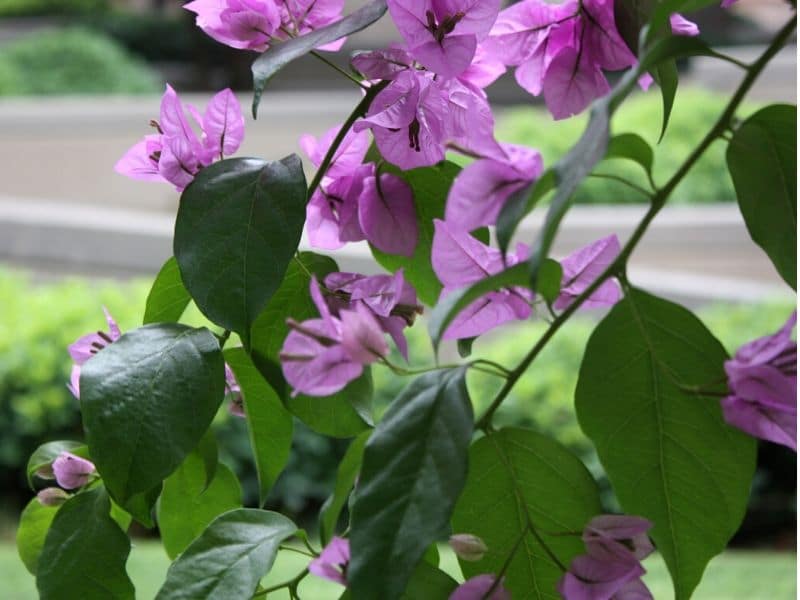
If taken care of well this climbing bush will reward you with blossoms from late spring to late autumn. It reminds people of exotic islands and sunny destinations. It is one of the most beautiful climbing bushes you can have in your garden.
Bougainvillea is drought-resistant but prefers regular watering and well-drained soil. It can be found in different colors, including purple, pink, red and burgundy. It enjoys direct sunlight and needs support (e.g. wall) to climb on.
It is relatively easy to grow and care and once well developed it does not require significant efforts to be maintained.
#24. Carnation
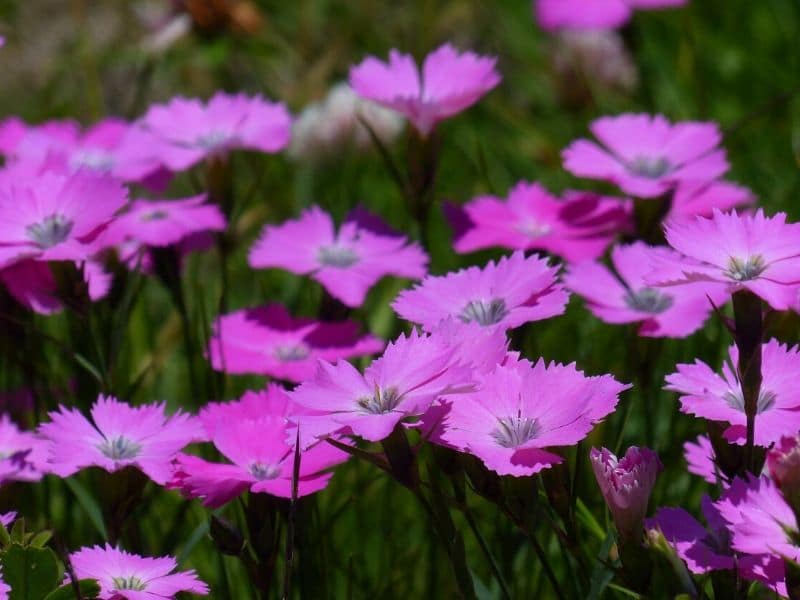
Carnations also come in different sorts, sizes, shapes, and colors but the majority of the types will reward you with beautiful continuous blooming and soft fragrance which often attracts butterflies too.
Different sorts of carnations can be used for filling varying gaps in your garden (e.g. borderlines, floral baskets, etc.). Their blooming period varies depending on the sort but usually, it lasts from early spring to late autumn.
Carnations enjoy some direct sunlight for a couple of hours during the day but if the weather is too hot, they can burn if exposed to it for the whole day. To encourage more and longer blooming, remove the dead heads from the plant.
#25. Sea Thistle
This weirdly shaped perennial can be a unique addition to your garden which will give it a different unconventional appearance. Its globe-like blossoms are often a reason why it is also used as a cut flower in bouquets and floral decorations.
It attracts butterflies, bees and hummingbirds which can further contribute to your garden fairytale. Sea Thistles prefer average watering, well-drained soil and location exposed to direct sunlight for the majority of the day.
We advise you to use gloves when you care for this plant because its edges are very sharp. It is self-spreading from seeds in the heads of the blossom, so keep this in mind when you choose where to plant it.
#26. Crocus
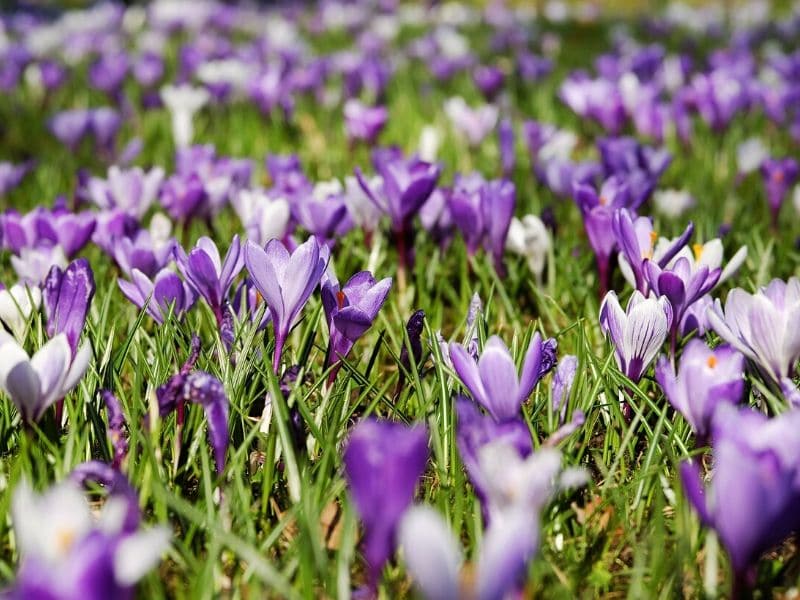
Crocus is one of the signs of an upcoming spring as it starts growing even before all snow is melted. This flower can grow between 2 and 4 inches in height and can be found in a variety of colors, including purple, pink, white, blue, yellow and orange.
Crocus is grown from a bulb that is easily spreading every next year, so keep this in mind when choosing the area to plant them, as it might easily become covered by their blooms. When planting them, make sure you put the bulbs 3 to 4 inches deep in the ground.
These flowers require minimum maintenance and care. They generally prefer areas with partial shade or full direct sunlight and moderate watering.
#27. Columbine

These flowers are an amazing addition to your mid-spring to early summer blooming garden. They form bell-shaped rosettes that come in a wide variety of colors, including purple, pink, red, yellow, orange and mixtures of these.
They are drought tolerant which makes them relatively easy to grow and care. Columbines prefer areas with partial shade or full direct sunlight, moderate watering and well-drained soil.
As they also enjoy mild climate conditions, you might use a mulch to keep the soil moist and to serve as insulation and protection for the winter period.
#28. Bell Heather
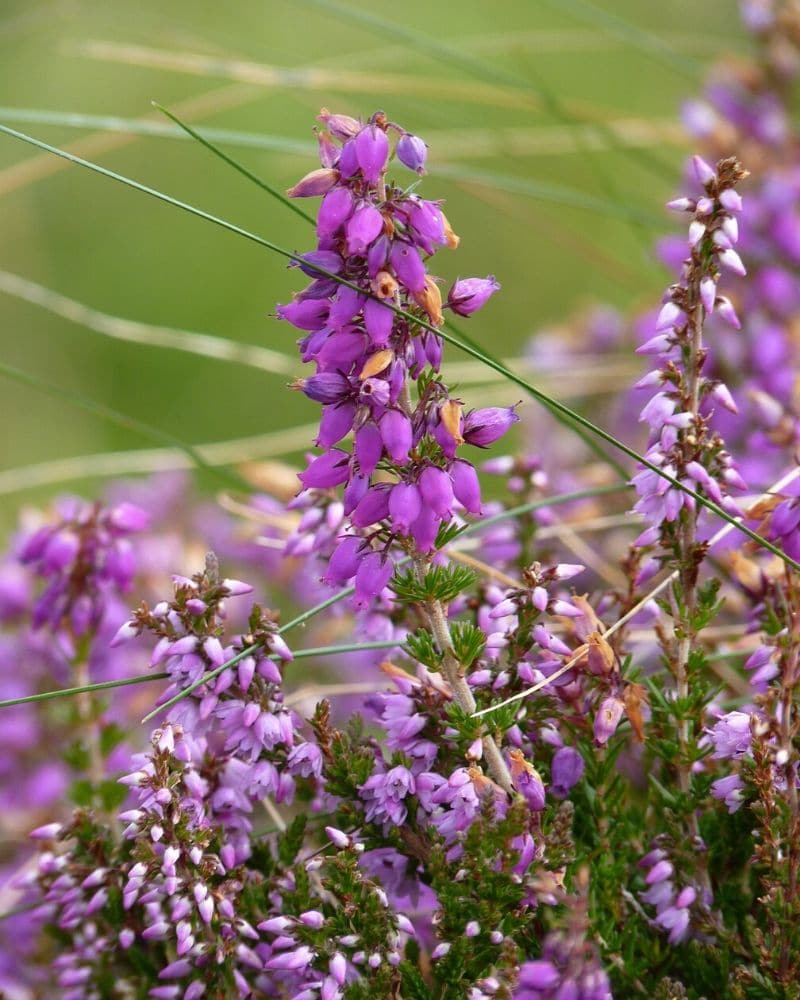
It is one of the most preferred flowers in the heath family. This flower is a low-growing shrub that blooms with purple bell-shaped blossoms. It enjoys direct full sunlight, regular watering, and well-drained soil. If you want to encourage blooming, you can use appropriate fertilizers.
#29. Foxglove
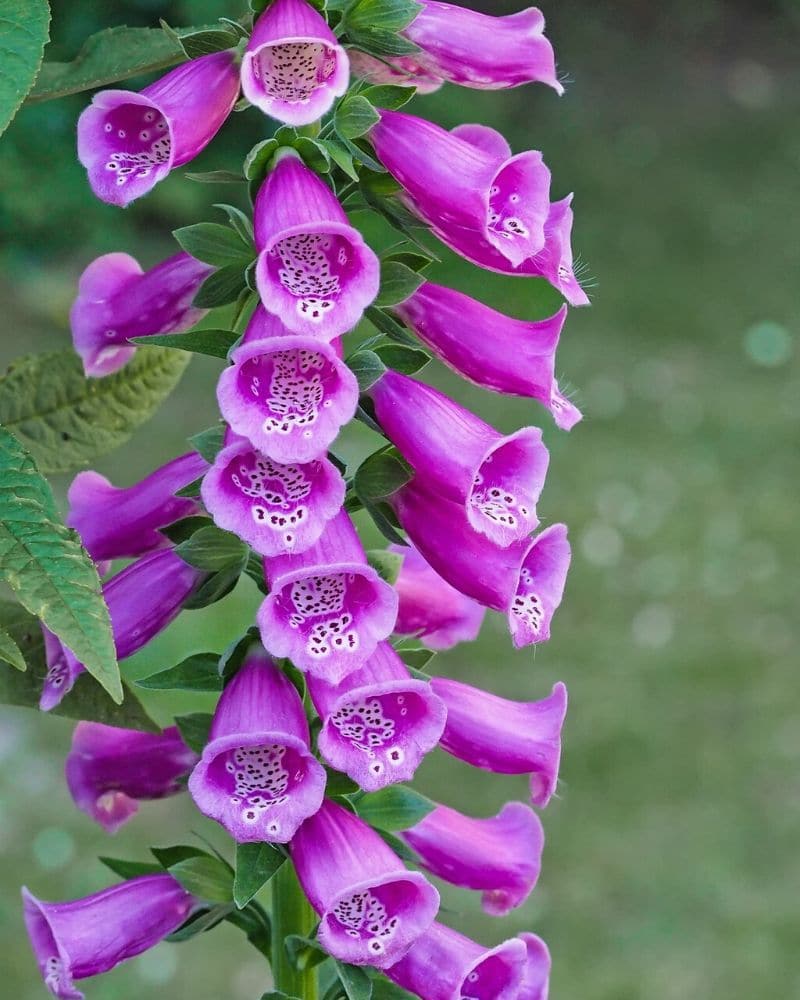
Foxgloves are extremely pretty flowers that are relatively easy to grow and care which makes them a preferred choice for many gardeners. Although there are many varieties of foxgloves, the majority of them are biennials – developing roots during the first year, blooming in the second and then dying.
However, they are easily spread from seeds of the blossoms and thus, can grow all over again without additional effort. Foxgloves grow up to 6 feet in height and 2.5 feet in width. They are enjoying areas with partial shade and some sunlight during the day, moderate watering and well-drained soil.
Warning: All parts of this plant are partially toxic, so it is better to plant them away from areas that are easily accessible by kids or pets.
#30. Comfrey
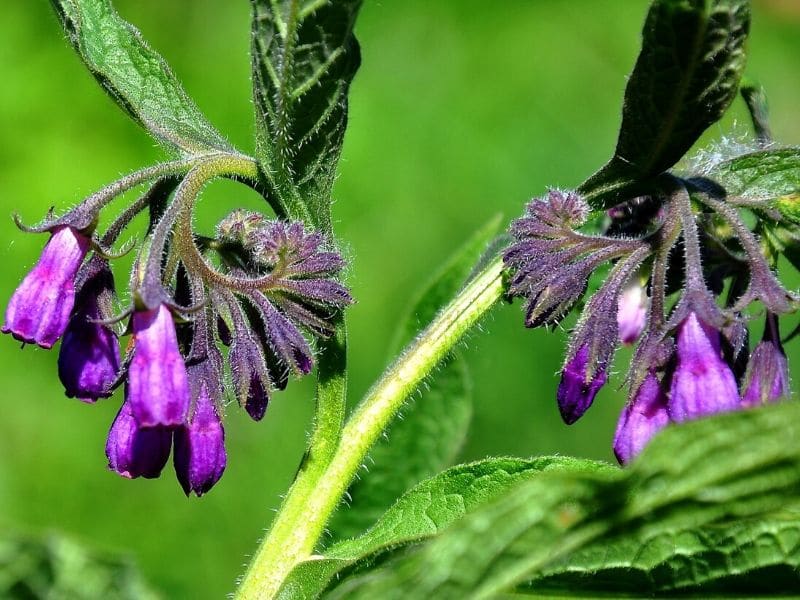
In the past, this beautiful perennial has been grown as a medicinal herb as it helps for skin irritations, cuts, and swelling. However, if taken internally, it can become carcinogenic, so you need to be very careful with that.
It is a tall plant which is very easy to take care of. It reaches up to five feet in height and form clusters of deep purple blooms on the top. Comfreys are very drought tolerant which makes them easy for growing and appropriate for areas with more restricted access to water.
It prefers direct full sunlight or partial shade and blooms in late spring or early summer. It can be found in three main colors, including purple, pink and creamy yellow.
#31. Catmint

This flower is relatively easy to grow and care and has a long blooming period. It has gray-green foliage and reaches up to 2 feet in height. It enjoys direct full sunlight during the majority of the day, average watering and well-drained soil.
This flower is also drought tolerant which makes it easily adjustable to such climates and regions.
#32. Fuchsia

Fuchsia’s distinctive beauty is often a reason for gardeners to use it in forming their piece of paradise. There are more than 100 varieties of this flower ranging in colors and shapes.
In the majority of cases, it forms a bush-like plant with draping, lantern-like blossoms that come in several color varieties and combinations among which purple, pink and red are most common.
Very often, fuchsias are planted in hanging baskets and used in hanging floral decorations for the creation of a blooming waterfall. Fuchsias grow up to 30 inches in height and width and prefer partial shade areas, regular watering, and well-drained soil.
They can also grow in more sunny areas but are quite sensitive to significant heat or sun exposure for a long period of the day, so you have to be careful when choosing where to plant them.
#33. Gladiolus

These beautiful flowers grow from bulbs and form long stems full of blooms during summer. They are often preferred by gardeners due to their impressive appearance and beauty and are also used in floral decorations as cut flowers. They grow from bulbs that are best to be planted in the autumn.
Due to their height, it is a good idea to plant gladiolus next to a wall or provide them with a certain type of support to prevent them from breaking or falling. These flowers enjoy direct and full sunlight, regular watering and well-drained soil.
Their flowers bloom in a rich and wide variety of colors, including purple, pink, red, yellow, white, burgundy and orange.
#34. Geranium
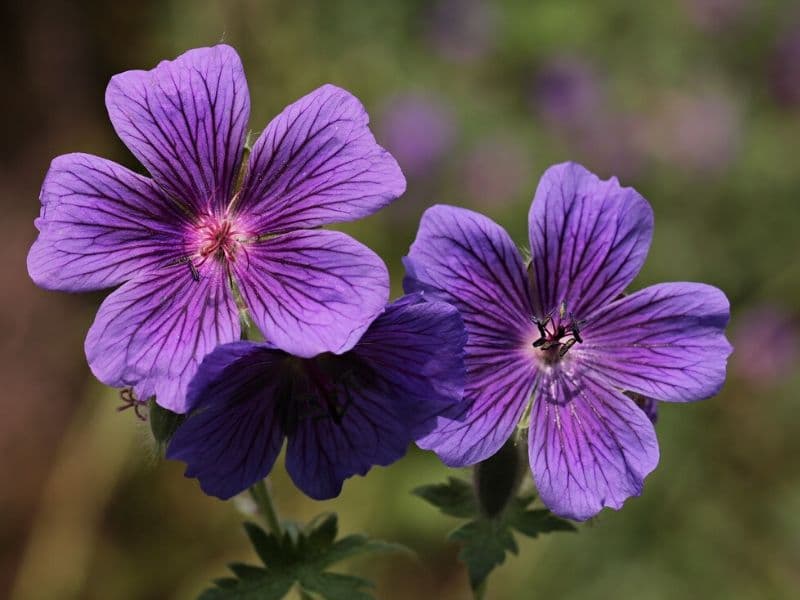
Geraniums are often preferred as a part of gardeners’ choice mainly due to their long blooming period which lasts from early spring to late autumn. They can be found in many colors, including purple, pink, blue, white, yellow, red and burgundy.
Geranium prefers full direct sunlight, moderate watering, and well-drained soil. It grows up to 14 inches in height and 30 inches in width.
Very often, these flowers are used as a part of basket floral decorations due to the relatively low maintenance they require, the color palette they can be found in and the long blooming period they have which makes them appropriate for different seasonal arrangements.
#35. Bee Orchid
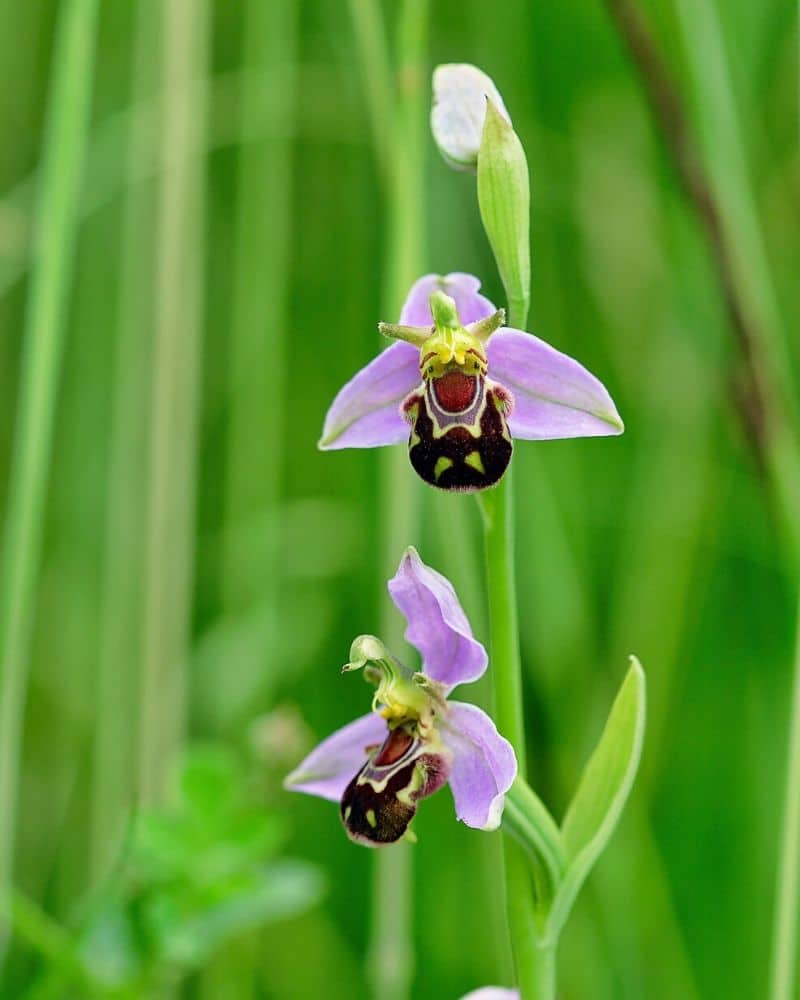
This kind of orchid is named after its shape and its ability to attract bees. It can be found in a variety of colors but purple is one of the most common. It prefers average watering and moist but well-drained soil.
This flower enjoys sunlight and can grow in sunny or partially shady locations. However, it is relatively sensitive to strong direct sunlight for the whole day and might burn. It is better grown indoor but can also develop well outdoor if the conditions are appropriate.
#36. Baptisia
As known as False indigo, this striking perennial needs minimum care and is relatively easy to grow. Apart from purple and blue, this flower can also be found in white and yellow.
Baptisia enjoys average watering, well-drained soil and full sunlight for the majority of the day. Its foliage can grow up to three feet in height and its spikes of blossoms – to an additional 13 to 25 inches.
The blooming period of this flower is usually mid-spring to early summer and lasts for approximately six weeks.
#37. Coneflower

This daisy-like flower is one of the most popular perennials due to its significant tolerance towards drought and relative ease of care.
Purple coneflowers are also preferred by gardeners for their ability to attract butterflies and birds, which will contribute to your backyard paradise.
This flower prefers areas with full direct sunlight, regular watering, and well-drained soil. To encourage longer and more blooming, remove dead flowers.
#38. Aster

This autumn flower can give your garden an amazingly beautiful end of the blossom seasons for the year. It differs significantly in terms of sizes, shapes, colors, and sorts. It is also known as ‘frost flower’ because of its ability to bloom until the first winter frost.
It is quite adaptive to different climates, which makes it a preferred choice by gardeners. It enjoys regular watering and well-drained soil. It grows best when exposed to partial sunlight and partial shade for different parts of the day.
Asters have had an important symbolic meaning for ancient tribes and leaders as they were believed to send evil away.
#39. Petunia

Although they are annuals, petunias are often selected by gardeners because of their rich and colorful blooming during the summer and the fragrance they have which contributes to the creation of a real outdoor paradise. Also, they require minimum maintenance and are relatively easy to grow and care.
Different types of petunias are characterized by a variety of shapes and sorts. Some of them are hanging and appropriate for baskets, while others are relatively short and non-hanging and can be used for border lines in your garden.
Petunias can grow up to 4 feet in height and width depending on the type. They enjoy areas with full direct sunlight, regular watering, and well-drained soil. Water is very important for growing healthy petunias, so you have to keep it in mind when deciding how to combine it with other flowers (it is best to choose flowers with relatively the same or similar needs for growing and care).
To encourage more and longer blooming, you can remove the dead flowers from the plant.
#40. Hibiscus

Hibiscus shrubs are an amazing exotic addition to any garden. If properly grown and cared for, they will bloom from early spring to late autumn. They can be found in many different colors, ranging from purple through red to yellow and white.
They enjoy direct sunlight but if the weather is too hot you have to water them regularly and ensure they are planted in well-drained soil. To encourage more blooming, remove the dead flowers from the plant.
#41. Lupine
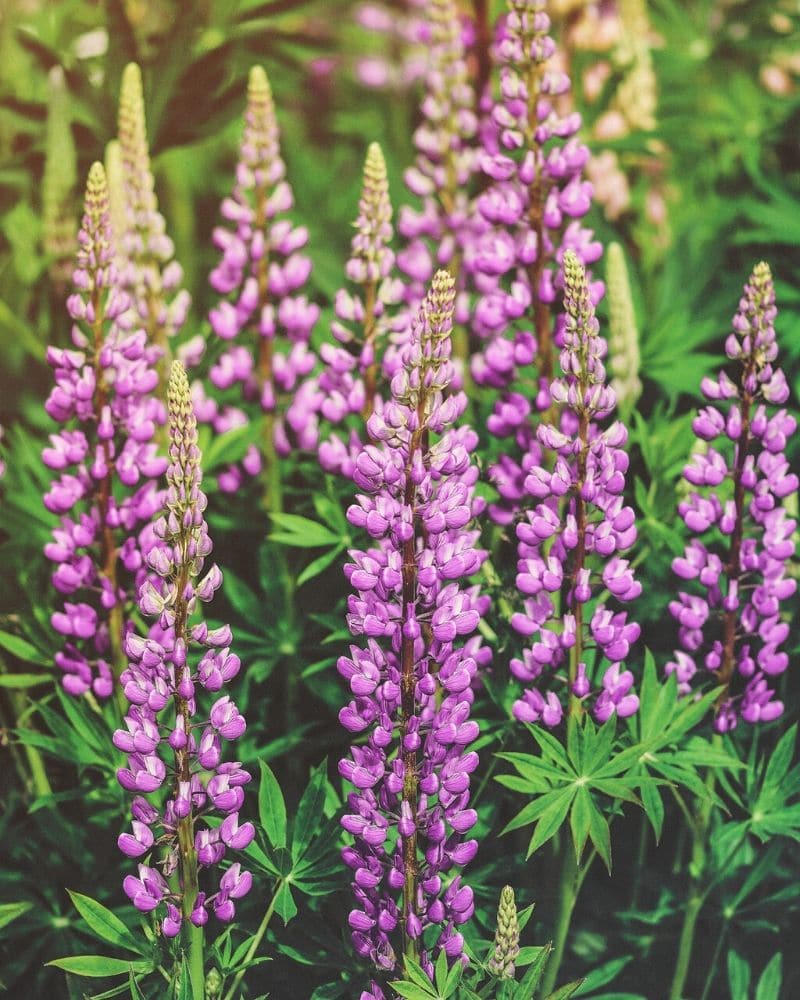
Lupine flowers are tall and full of blossoms when they bloom, which is why they are often used in floral decorations as cut flowers. They prefer areas with full direct sunlight, well-drained soil and average watering.
Lupines can be found in many different colors, including pink, purple and blue and are often mixed in gardens to create a colorful accent among other plants. Lupines grow up to 5 feet in height which is often the reason why they are used as a colorful background for shorter flowers.
#42. Lily

Lilies are always a good choice for gardeners. They can be found in a wide variety of sorts, shapes, sizes, and colors. Usually, they bloom throughout the summer season. Once developed well, lilies are relatively easy to grow and care and require minimum efforts to be maintained for a long-term presence in your garden.
Most lilies’ blossoms have six purple petals and are trumpet-shaped, topping a tall stem with lance-shaped foliage. These trumpet shaped flowers are usually growing up to 3 feet in height and prefer direct sunlight for the majority of the day, regular watering and well-drained soil.
#43. Periwinkle
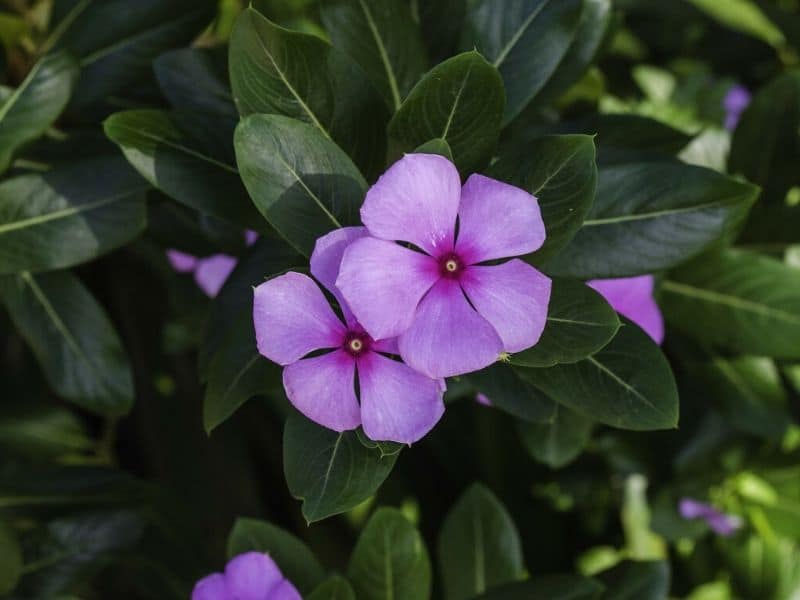
This plant is a short bush-like perennial which blooms with pretty and fragrant floral rosettes. It is often used as a floral carpet to ground cover areas around areas that are green and are lacking colors
It prefers shady areas with less direct sunlight, moderate watering, and well-drained soil. It is drought-resistant which makes it relatively easy to grow and care.
#44. Iris
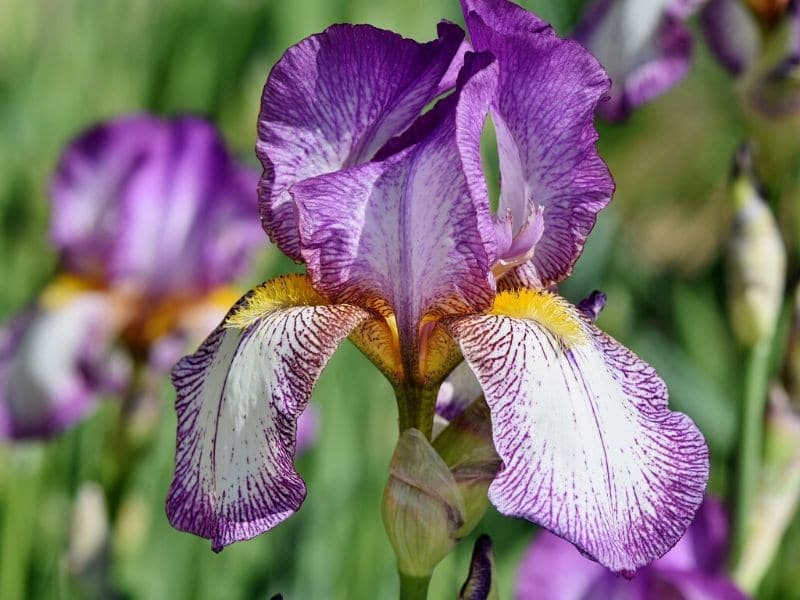
This flower is named after the Greek goddess of the rainbow. The flower blooms in a rich palette of colors, pink being one of the most common. Irises are relatively easy to grow and care and reward their owners with tall rich blossoms in late spring and early summer.
The sizes of the plant would vary according to the specific sort selected but on average they are approximately 28 inches in height. The blossom of the flower is six-petaled and usually combines a mixture of two or more colors on the rosette.
If taken care of well, irises may bloom later in summer again. They are very often used as materials for floral decorations and also attract hummingbirds and butterflies.
Iris flowers prefer full direct sunlight for the majority of the day (which is of significant importance for their blooming pattern), well-drained soil and moderate watering (too much watering causes roots to rot). To encourage better growing and blooming of the flower, remove all old foliage in the spring to allow fresh leaves to grow.
#45. Morning glory
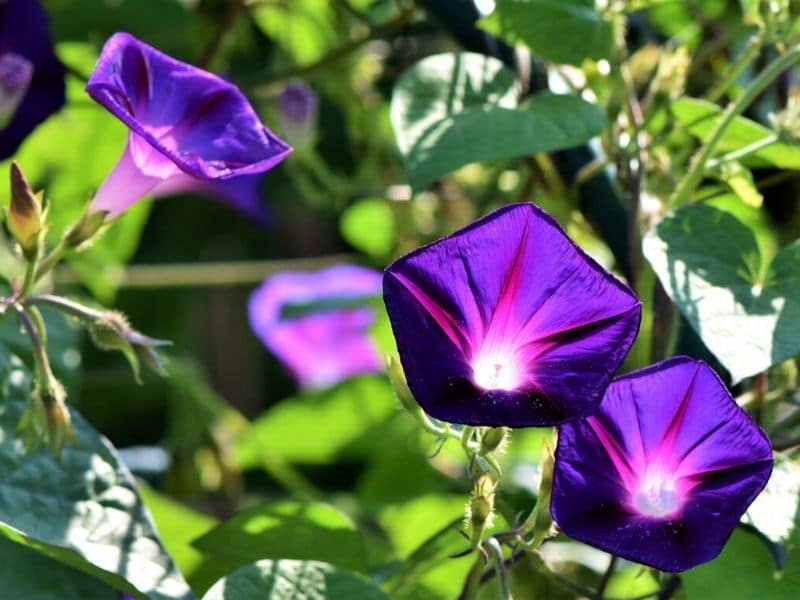
Morning glories are a very beautiful addition for your daily garden, as they bloom only in the daytime. They form many saucer-shaped blossoms and can be found in a variety of colors including purple, blue, pink, yellow and red.
Morning glories flowers are closing during the night and open again in the morning. They prefer areas with direct full sunlight, regular watering, and well-drained soil. They are also featured with a relatively long blooming period.
#46. Anemone
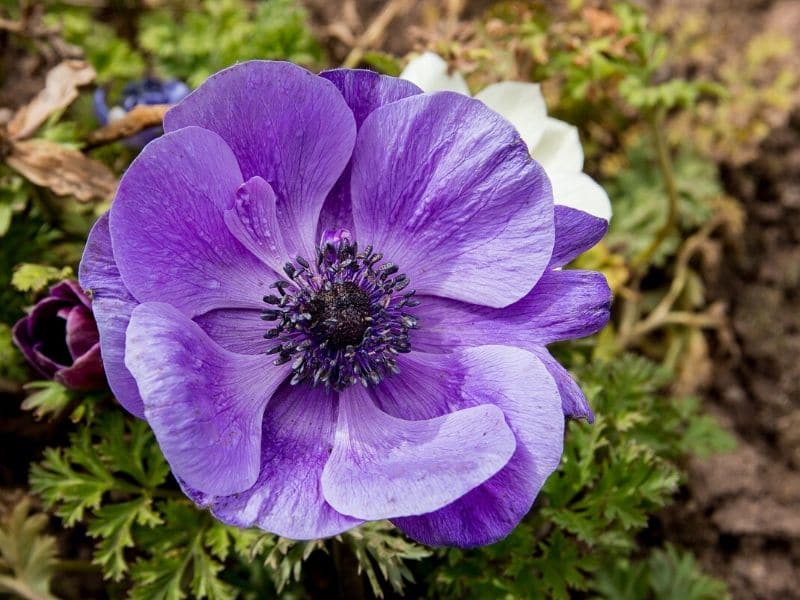
These flowers have low-growing foliage and rich-colored blossoms which range in a wide variety of palettes, including purple, pink, blue, white, red and yellow. Depending on the specific sort chosen, anemones bloom either in the spring or in the autumn. They are spreading relatively easy, so keep this in mind when choosing their location in your garden.
They grow from bulbs and each one of them can grow up to 20 times per year if well-taken care of. Anemones enjoy direct sunlight, regular watering, and well-drained soil. They can also grow in partially shady locations.
#47. Mystic Merline
Also known as French mallow, this is a very pretty flower that is popular for its magical appearance and rich purple blooms. They have a relatively long blooming period and are prefer partial shade or fully sunny areas, which makes them ideal for cottage gardens.
However, when they are young, the plants are very sensitive which is why it is advised to have them indoor until they develop well and then transplant them in the garden.
#48. Balloon flower
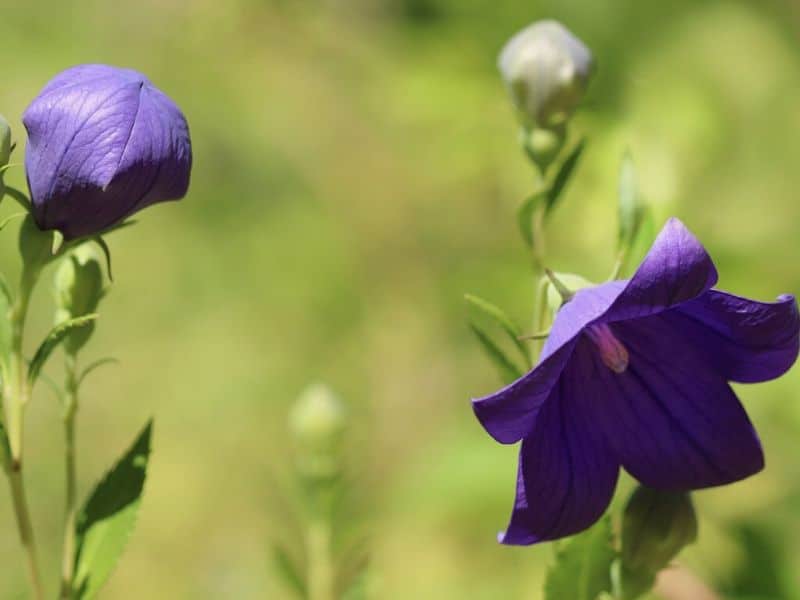
Named after its balloon-shaped blossoms that have this shape right before blooming, this flower is one of the symbols of love and honesty. The most common color varieties of balloon flowers are purple, blue, pink and white.
This flowering plant grows well under partial shade as it is not very resistant to very high summer temperatures and prefers well-drained but moist soil.
This is one of the easy-to-take-care-of flowers which, once developed, requires minimum care. Balloon flowers are very appropriate to be used as a part of flower baskets or arrangements.
#49. Scabiosa
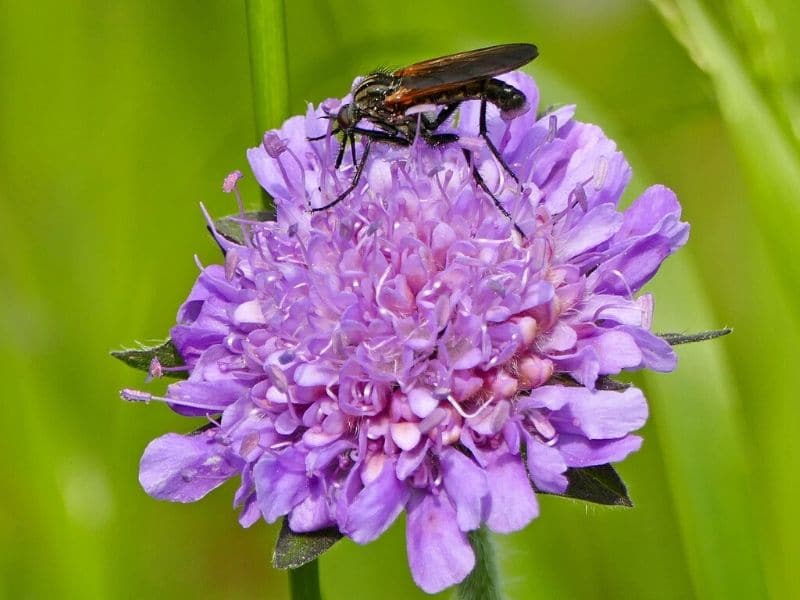
This flower forms pincushion-like blossoms and an outer layer of petals which makes it very attractive and catchy for the eye. It can serve as an accent in a garden that doesn’t have a lot of bright colors. It blooms during the summer and can be found in blue, white and purple colors.
It prefers areas with full direct sunlight and enjoys regular watering, as well as well-drained soil. To encourage longer and more blooming, it is advised to remove dead blossoms from the plant.
#50. Hydrangea

Hydrangea is one of my favorite flowers when the spring-summer blooming season is considered. It comes in many different colors and can be found in purple, blue, pink, white and even light green.
The color palette depends on the alkalinity of the soil in which it is planted. It is resistant to normal winter conditions and can survive the season without having to be moved to a warmer place.
Its leaves fall in autumn and in the spring they grow again forming new foliage. It is good to provide some support to the stems as they are not very strong and can break easily.
#51. Blue-eyed grass

This is a beautiful wildflower perennial. When developed well, it forms long green foliage with small bright purple flowers. This flower enjoys partial shade protecting it from sunburn, average watering, and well-drained soil.
We advise you to not cut the foliage after the blooming ends, as it needs to collect energy for next season’s blossoming and this is why it is better to leave it dying naturally.
#52. Sea holly
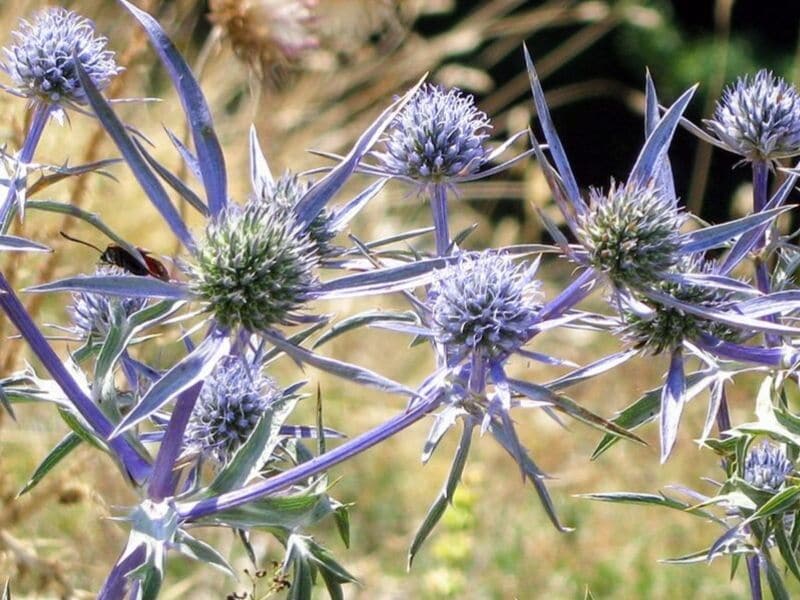
This flower has a distinctive and unconventional bloom and appearance which is why it is often chosen for modern-look garden designs. It has spiny leaves and blossoms. It is a flower that requires relatively low maintenance. It is drought-tolerant and prefers poor and dry soil to grow in.
#53. Bellflower
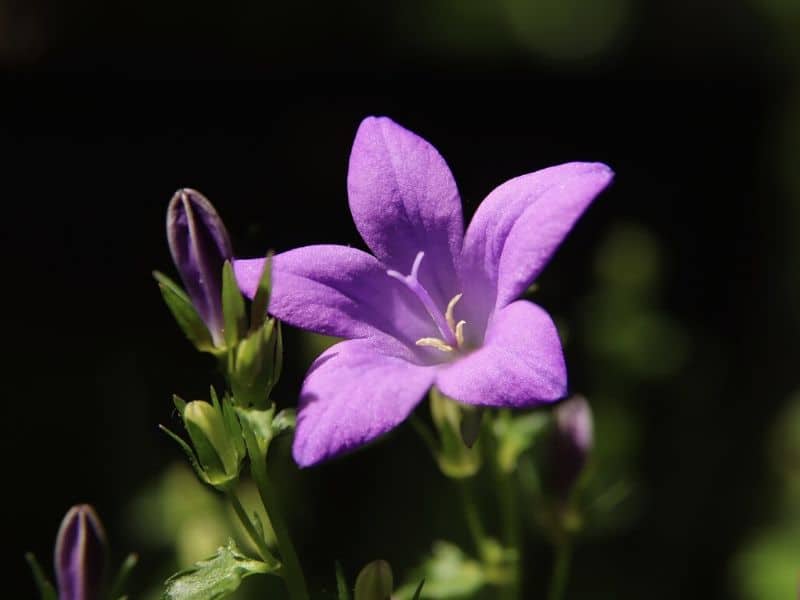
The bellflower is a short perennial (it also offers annual and biennials sorts) which blooms heavily from late spring to late summer or early autumn.
It prefers places where it would have some sunlight during the day but would also be provided with shade to protect the blossoms from burning. It needs regular watering and well-drained soil.
Bellflower blooms in purple, pink, white and blue. It is often attracting butterflies and birds.
#54. Chrysanthemum

This flower is an autumn-must for gardeners. It can be found in different colors, types, sizes and shapes, but the majority of them bloom in the autumn and form a blooming bush that can be cut-shaped in different forms, entirely based on your imagination.
Different sorts of chrysanthemum have varying grow and care needs but most of them require regular watering, well-drained soil and some direct sunlight but not during the whole day, especially if planted in warmer climate zones.
Most of the chrysanthemum sorts grow big and are often used as cut flowers for bouquets and floral decorations. To encourage more blooming, you might remove dead flowers from the plant.
#55. Zinnia
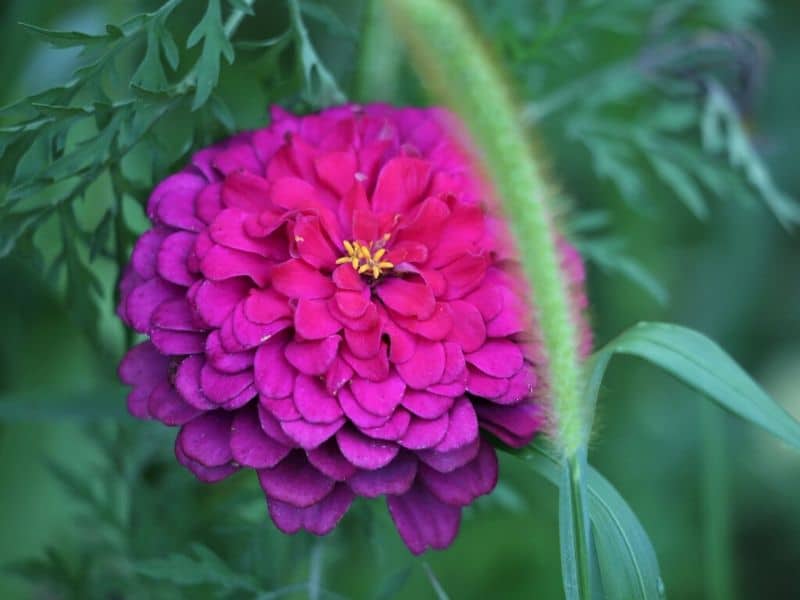
This flower is among top gardeners’ choices due to the wide variety of color palettes it can be found in, including purple, pink, yellow, red, white, burgundy and orange. It has a long blooming season and is often also used as a cut flower in different floral designs.
It prefers areas with full direct sunlight, regular watering, and well-drained soil. To encourage more and longer blooming, you can remove the dead blossoms from the plant.
#56. Cosmos
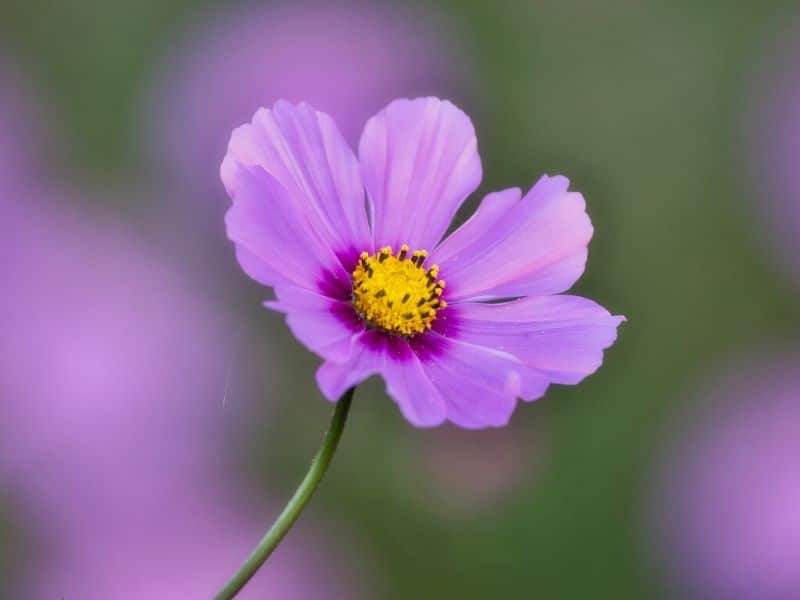
Despite being an annual, this flower can bring a lot of smiles and beauty in your garden. It has bowl-shaped blossoms topping long stems and blooms in rich purple color. It can also be used as a cut flower in different floral decorations.
Cosmos flowers enjoy full direct sunlight, regular watering, and well-drained soil. To encourage more and longer blooming, you might remove the dead flowers from the plant.
#57. Pasque flower
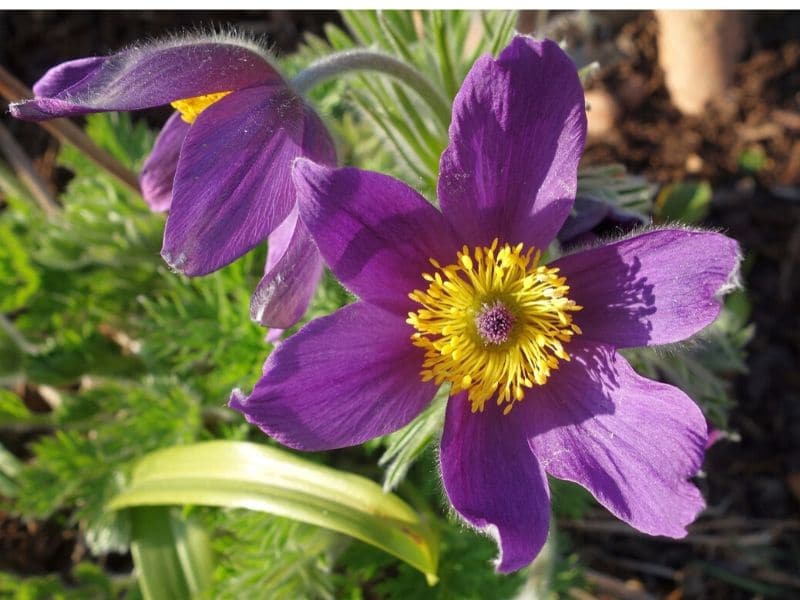
This is one of the most beautiful spring bloomers that can give your garden a romantic touch. It enjoys direct sunlight, infrequent watering, and well-drained soil.
This flower is drought tolerant which makes it easily adjustable to various weather conditions and easy to grow and care. They can grow up to 10 inches in height and 12 inches in width. These flowers are very appropriate for your rock gardens and garden designs.
#58. Bittersweet nightshade
This blooming vine is not appropriate for gardens which are easily accessible by pets as it is poisonous for animals.
It is a beautiful floral addition that enjoys partial shade, regular watering, and well-drained soil. It is relatively fast-growing and easily spreading, so keep this in mind when you select its position in your garden.
#59. Alpine betony (Stachys monieri)
This perennial blooms with bright purple flowers on the top of beautiful green foliage. Its blooming season is usually early summer, although in some regions this period can be longer.
These lovely purple flowers prefer average watering and well-drained soil and full exposure to sunlight. It can grow up to 24 inches in height and 18 inches in width, so keep this in mind when choosing the planting location in your garden.
It is very resistant to low winter temperatures which makes it a preferred choice for regions with such.
#60. Salvia (sage)

Salvia is one of the most impressive all-season bloomers that you can have in your garden. It is easily adaptable to different soil and climate conditions. It prefers full direct sunshine but if temperatures are too high in the summer, it will grow best in partial shade at least for part of the day.
Salvia can be found in different shapes and colors and the majority of sorts are also characterized by the strong and aromatic fragrance. We advise you to divide salvia plants every three years during early spring, before the development of new greenery starts.
Salvia is also known for its health benefits and is very often used as a herb.
FAQs
What do purple flowers mean LGBT?
While the meaning of flower colors can vary, purple flowers, including violet or lavender blooms, are sometimes associated with LGBTQ+ pride and solidarity. The use of purple in this context is not universal, but it can symbolize diversity and support within the community.
What is the most popular purple flowers?
The lavender, or Lavandula, is one of the most popular purple flowers, known for its fragrant blooms and versatile uses in gardens, bouquets, and aromatherapy. Its calming scent and distinctive color contribute to its widespread popularity.
What purple flower means love?
The purple lilac is often associated with love and deep emotions. Its rich color and sweet fragrance make it a symbol of affection, making it a popular choice for expressing love and admiration.
References
Reference List:
[1] Bortoli, M., Maroto, J. (2001) Colours Across Cultures: Translating Colours in Interactive Marketing Communications. Proceedings of the European Languages And The Implementation of Communication and Information Technologies Conference. University of Paisley.
[2] Nezhad, Z., Kavehnezhad, K. (2013) Choosing The Right Color: A Way To Increase Sales. International Journal of Asian Social Sciences. Vol. 3 (6), pp. 1442-1457.
Close

